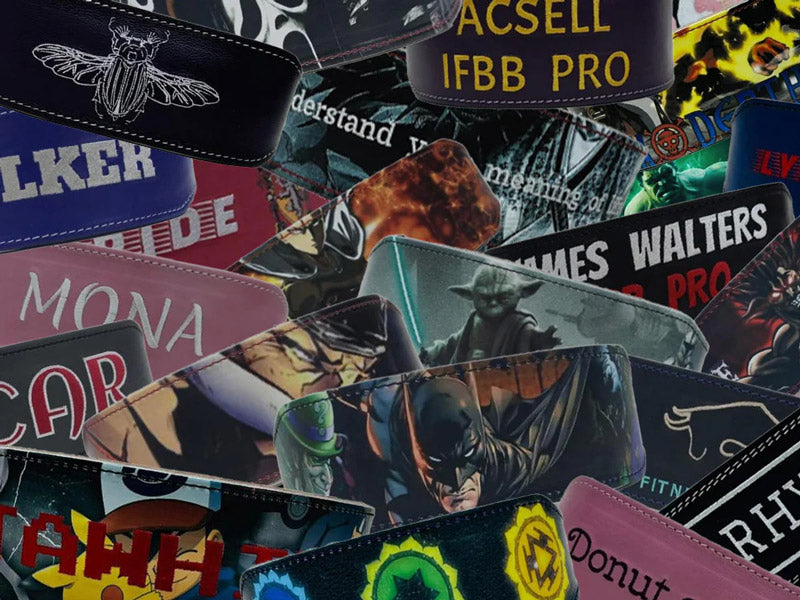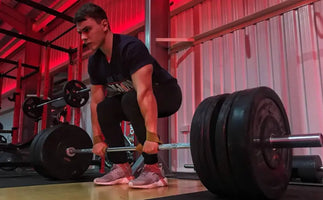![How Tight Should a Weightlifting Belt Be? [Full Guide & Tips!] - Gunsmith Fitness](http://gunsmithfitness.com/cdn/shop/articles/how-tight-should-a-weightlifting-belt-be-full-guide-tips-491867.jpg?v=1710322916&width=1920)
How Tight Should a Weightlifting Belt Be? [Full Guide & Tips!]
Making sure your weightlifting belt fits properly is the key to taking your lifts to the next level.
The right amount of pressure from a weightlifting belt can provide optimal support for your spine, enhance your performance, and drastically reduce the risk of injury. But wearing it too tight has the opposite effect.
Your weightlifting belt is a tool you can use to your advantage at the gym, so it’s hard to determine if it fits right based on comfort.
If you’re not sure how tight a weightlifting belt should be, you’re in the right place.
We’ll take you through a guide on finding the ideal tightness for your belt so you can make every lift your best one yet.

What Is A Weightlifting Belt?
A weightlifting belt is a piece of gym equipment that boosts safety and performance in strength training by reducing stress on the spine during heavy lifts. Studies show that it can limit unwanted movements like bending and twisting of the spine.
Using a lifting belt correctly can stabilize your spine by increasing pressure within your abdomen, which supports your back and improves your form during lifts. The belt encourages you to lift with your legs rather than your back and improves your posture, which can help you prevent injuries.
In addition to keeping you safe, weightlifting belts also enhance your performance by supporting your lower back and abdomen. This increases your core stability and can even improve your breathing technique during lifts, especially when you use the Valsalva maneuver.
How Tight Should Your Belt Be?
As a general rule, you should be able to comfortably fit two thumbs between your abdomen and the weightlifting belt you’re wearing.
If the belt is comfortable enough for you to wear it between sets or during exercises where you don’t even need it, it’s probably too loose.
But fastening your belt to the max won’t increase your gym performance either. Weightlifting belts don’t magically help you lift more weight - you need proper technique and training to do that.
Learning how to tighten your belt and use it properly helps you decrease your chance of injury and go further on your weightlifting journey.
What Influences How Tight A Weightlifting Belt Is?
Not every weightlifting belt is the same, and there are a few key elements that determine how tight yours is going to feel.
These can range from the material the belt is made from to the specific exercises you do while wearing it.
Let’s take a look at the details:
#1. Individual Body Anatomy
Every human body is unique, so belt tightness preferences are just as varied.
People who have more rounded bellies might need to wear their weightlifting belts lower to get the most out of them.
Similarly, if you’re lean, you might have to adjust your belt higher up, around your natural waistline, and tighten it more.
The length of your torso can also affect how the belt fits you and how much you can comfortably tighten it, so you have to find the best weightlifting belt for you.
#2. Belt Material
Your weightlifting belt’s material significantly affects its fit and comfort.
Leather belts are thicker and give sturdy support since they press against your abdomen more evenly. But they’re also less flexible and harder to adjust on the go. If you fasten your leather belt too tightly, you may feel some discomfort and even hinder your workout.
In contrast, neoprene or nylon belts are thinner and more flexible, so they tend to be more comfortable. The downside is that they might not deliver the same level of support you’d need for extremely heavy lifts.
Make sure you choose a belt based on whether you need more support or flexibility.
#3. Belt Fastening
The type of closure on a weightlifting belt also impacts how tight you can wear it.
For example, buckle closures allow you to make precise adjustments to achieve the perfect fit. You can choose between single or double-prong buckles for that extra support.
Lever closures, on the other hand, are a “set it and forget it” type of fastening. It’s quick and easy to set, but you won’t be able to adjust how tight it is.
Fabric belts are fastened with velcro strips, so they’re easy to put on and allow for a lot of adjustments during your workout.
#4. Specific Exercises
How much you need to tighten your lifting belt is going to depend on your workout.
Generally, strength-focused exercises need a tighter belt for enhanced back support and increased intra-abdominal pressure.
Here’s when you should wear a tighter weightlifting belt:
- During high-intensity workouts that involve heavy loading.
- When lifting near or at your maximum capacity.
- For any moves that need an extraordinary amount of core stabilization.
On the other hand, conditioning exercises that require more movement should be done with a looser belt.
Here are some workouts that can be done with a slightly looser belt:
- Aerobic or circuit-based training is where you’re moving quickly between exercises.
- Mobility-focused exercises where a tight belt could restrict your range of motion.
- Lighter strength-training sessions or warm-up sets.
Just remember that 'loose' doesn't mean 'hanging off.' Your belt should still provide support and stability to protect your lumbar region from potential injury; it just doesn't need to be as tight as it would be for heavy lifting.
6 Steps To Finding The Optimal Tightness For Your Belt
If you indeed need a weightlifting belt, you need to know how to wear it effectively.
Figuring out how tight your weightlifting belt should be doesn’t need to be hard. So, we’ve divided it into easy-to-follow steps.
#1. Understand Your Body
The first step to finding the ideal tightness for your weightlifting belt is to understand your body.
Things like your waist size, abdominal muscle mass, natural curvature of your spine, and flexibility all significantly impact how your belt fits.
Take the time to get to know your body and its limits, so you can find a belt that fits just right. This way, you can easily order a custom weightlifting belt and find the ideal fit in no time.
#2. Consider The Exercise
Different exercises need different degrees of tightness.
Compound exercises like squats tend to need tighter belts since they put a lot of pressure on your lower back. Meanwhile, isolation exercises, like curls or tricep extensions, can work with a looser belt since they don’t impact your core as much.
Let’s look at some specific examples:
- Squats. These are powerful lifts where a weightlifting belt can allow maximal pressure and stabilize your core. You need a tight belt with just enough space under it to be able to brace and create intra-abdominal tension.
- Bench Press. Wearing a snug weightlifting belt during bench press can help you use your core better and improve your training session, so long as the belt isn’t too tight. You need to take deep breaths to do it safely.
- Deadlift. Since deadlifts require you to keep your torso straight but relaxed, a very tight belt could limit your movements and affect how well you perform. Choose a fit that's tight enough to support you without restricting you. Depending on the weight you plan on lifting, you might want to consider wearing lifting straps along with your belt.
- Snatch. This is a fast and precise move that needs some flexibility around your waist. You might need to loosen the belt a bit compared to other exercises to get comfortable.
- Clean & Jerk. For quick movements that use deep breaths, you need to adjust your belt accordingly. The clean and jerk uses a lot of power, from your legs to overhead, so you want to make sure you have the support you need without gasping for air.
- Kettlebell Swings. A looser belt ensures a full range of motion and flexibility that you’ll need for this exercise.
- Power Cleans. This explosive lift and rapid movement from the ground to the shoulder require maximum stability, so a tighter-fitting belt provides more core engagement.
- Medicine Ball Throws. Throwing exercises come with dynamic, varied movements, so it’s best to wear a looser lifting belt to maintain your agility and comfort.
#3. Evaluate Personal Comfort
Every lifter has a different level of pressure they’re comfortable with.
Don’t force yourself to wear a belt that’s too restrictive if it doesn’t feel right, and don’t wear your belt too loose if you think you can wear it tighter.
Your personal comfort is crucial when figuring out how tight your weightlifting belt should be. Aim for a snug fit that allows you to breathe and move freely while still supporting your core.
#4. Experiment Gradually
To find the right belt tightness, you’re going to need to take it slow and steady.
Start with lighter exercises and experiment with various levels of tightness. Keep track of any discomfort or limited range of mobility.
A careful approach can help you find the perfect balance between support and flexibility. Depending on the exercises, you might want to include knee sleeves in your routine, too.
#5. Reflect Post-Workout
After working out with your belt, take time to think about how it felt.
Check if there were any uncomfortable spots or if the belt moved out of place. Keeping an eye on these details helps decide if you need to make changes for next time and lift safely.
#6. Keep Refining It
Finding the ideal belt tightness is an ongoing process.
You’re going to need regular adjustments since the intensity of your workout, your body composition, and your flexibility all change. What works one day might be too tight the next.
Stay patient and attentive to minor shifts in how the belt feels, and use them to guide you so you can make any necessary tweaks and make sure your belt always fits just right.

7 Common Weightlifting Belt Mistakes
It takes time to figure out what the ideal fit for your weightlifting belt is going to be, and it can be challenging.
There are plenty of common mistakes that both beginners and experienced lifters make, and knowing what they are can help you make the most of your lifting belt.
Here are the most common mistakes you should look out for while getting used to your lifting belt:
#1. Replacing Good Form With A Good Belt
A weightlifting belt is not a substitute for good form.
While belts are a great way to support your muscles while lifting, you should never rely on a belt to correct your posture or improve your technique.
If you don’t invest enough time into improving your form, you increase your risk of getting injured, and the weightlifting belt won’t be able to help you.
#2. Not Positioning Your Belt Properly
The way you wear your weightlifting belt determines how effective it’s going to be.
A common mistake beginners make is wearing the belt either too high or too low on their waist.
Generally, your belt should lie around your belly button area and go around a part of your abdominal region and lower back muscles.
#3. Relying Too Much On The Belt
Some weightlifters start depending on their belts more than necessary.
Your weightlifting belt should complement your strength training exercises, not define them. If you feel like you can’t lift without your belt, you’re probably relying on it too much.
Make sure you work on strengthening your core independently to minimize your risk of injury and keep using your belt safely.
#4. Treating Weightlifting Belts Like A Fashion Accessory
There’s nothing wrong with choosing a weightlifting belt with a beautiful design or even going for something flashy.
The problem is that some lifters tend to wear weightlifting belts the same way they would wear a regular belt with their outfit – not too snug, just tight enough to keep everything in place.
But weightlifting belts are supposed to be firm for a reason, and your main priority should always be the belt’s functionality.
Unlike a regular belt, weightlifting belts are supposed to provide support and stability for your core during heavy lifts. If your favorite belt doesn’t engage your core muscles properly, you might want to rethink it and choose something that you can tighten.
#5. Not Leaving Room To Breathe And Brace
A weightlifting belt is supposed to constrict you since that’s how it supports your muscles.
However, if your belt is too tight, it might leave you gasping for air.
Anaerobic exercises like weightlifting still require plenty of oxygen flow, and you’ll hardly be able to complete a great set if you can’t breathe.
Likewise, if your belt is too tight, you might not be able to brace.
Bracing is essential in bodybuilding since it fills your lower abdomen with air during major lifts like squats or deadlifts. This gives you extra support during your training session, but if there’s no room for your body to expand under the belt, you’ll miss out on a critical safety measure.
#6. Ignoring Bloating
Bloating can happen to anyone, especially after meals or when taking certain supplements.
If your pre-workout meal leaves you feeling bloated at the gym, don’t ignore it.
Strapping on your weightlifting belt when you’re already bloated will add extra pressure to an already snug belt, and it can reduce your performance for the day.
Make sure you have enough room to handle any abdominal swelling without making your weightlifting belt uncomfortable or inefficient.
#7. Overlooking Digestive Problems
If you have any digestive issues, like Irritable Bowel Syndrome (IBS), wearing a weightlifting belt that applies too much pressure during your workouts can cause a lot of discomfort.
You have to be careful when deciding how tight you want your weightlifting belt to be and factor in any digestive problems you’re aware of.
Take your time to experiment by slightly reducing the tightness each time until you find a balance between comfort and effective core support. Over time, you’ll be able to avoid any digestive discomfort and enjoy better health and more successful workouts.
Frequently Asked Questions
Do you still have some questions about how tight a weightlifting belt should be? Check out the answers to some of the most popular questions on the topic.
#1. Can I Wear My Weightlifting Belt Throughout My Entire Workout?
Technically, you could wear your belt for the entire duration of your next training session, but we don’t recommend that you do.
Weightlifting belts are useful for heavy lifts where you need to stabilize your core. If you’re doing any isolation exercises or small compound movements like bicep curls or pull-ups, you’re not going to get the most out of the belt.
We recommend you wear the belt for the heavy lifting portion of your workout and remove it for all other exercises and stretches.
#2. Where Should The Weightlifting Belt Sit On My Body?
The exact placement of a weightlifting belt is different for everyone.
Generally speaking, the belt should encircle the midsection of your back muscles and sit on top of your hip bones up front.
However, individual anatomy plays a key role in determining where exactly the belt should be placed, so there isn’t a guaranteed one-size-fits-all solution for every weightlifter.
#3. How Often Should I Replace My Lifting Belts?
Your weightlifting belt’s lifespan depends on its quality and how often you use it.
A high-quality weightlifting belt can last for several years with proper maintenance. Cheaper belts, on the other hand, would need to be replaced more often.
#4. Do Different Exercises Affect How Tight My Weightlifting Belt Should Be?
Yes, different movements need various degrees of support from a lifting belt.
Some exercises, like the squat, should be done with a tighter belt to reduce unwanted movement in your torso.
Other exercises, like a deadlift or snatch, require more mobility and should be done with a looser belt.
Conclusion
In conclusion, knowing how tight your weightlifting belt should be is crucial for enhancing your lifting efficiency and minimizing your risk of injury.
Achieving the perfect belt fit is a process of trial and error, and it requires you to pay attention to how the belt feels during different lifting sessions. Keep in mind that different factors, like specific exercises or even bloating, can influence how your belt fits, so be prepared to make small adjustments as needed.
Focus on finding the right balance between support and comfort to lift safely and more efficiently. Using a weightlifting belt is all about enhancing your performance while protecting your body, so take the time to get your belt tightness just right.





